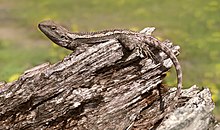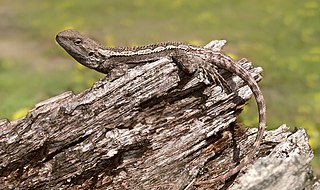
Amphibolurus is a genus of lizards in the family Agamidae. The genus is endemic to Australia.

Pogona is a genus of reptiles containing eight lizard species, which are often known by the common name bearded dragons. The name "bearded dragon" refers to the underside of the throat of the lizard, which can turn black and puff up for a number of reasons, most often as a result of stress, if they feel threatened, or are trying to entice a mate. They are a semiarboreal species, spending significant amounts of time on branches, in bushes, and near human habitation. Pogona species bask on rocks and exposed branches in the mornings and afternoons and sleep at night, making them a diurnal species. Their diet consists primarily of vegetation and some insects. They are found throughout much of Australia and inhabit environments such as deserts, and shrublands.

The central bearded dragon, also known as the inland bearded dragon, is a species of agamid lizard found in a wide range of arid to semiarid regions of eastern and central Australia.
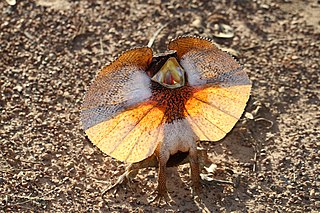
The frilled lizard, also known as the frillneck lizard, frill-necked lizard or frilled dragon, is a species of lizard in the family Agamidae. It is native to northern Australia and southern New Guinea. This species is the only member of the genus Chlamydosaurus. Its common names come from the large frill around its neck, which usually stays folded against the lizard's body. It reaches 90 cm (35 in) from head to tail and can weigh 600 g (1.3 lb). Males are larger and more robust than females. The lizard's body is generally grey, brown, orangish-brown, or black in colour. The frills have red, orange, yellow, or white colours.

The eastern bearded dragon, also known as common bearded dragon or simply bearded lizard, is an agamid lizard found in wooded parts of Australia. It is one of a group of species known commonly as bearded dragons. Other common names for this species include Jew lizard and frilly lizard, the latter being a confusion between this and another dragon, the frill-necked lizard. This species was originally described in 1829 by Georges Cuvier, who named it Amphibolurus barbatus.
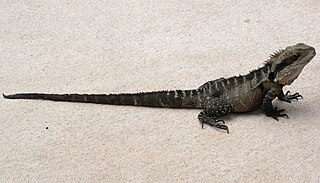
The Australian water dragon, which includes the eastern water dragon and the Gippsland water dragon subspecies, is an arboreal agamid species native to eastern Australia from Victoria northwards to Queensland. There may be a small introduced population on the south-east coast of South Australia. The Gippsland Water Dragon is generally the more southern of the two species and the more cold adapted and heat sensitive. Visually distinguishing the Gippsland Water Dragon from the Eastern Water Dragon is relatively easy, as long as their skin is reasonably clean and not stained from the water, as identification of the two subspecies depends largely on observable differences in colours and patterns.

Temperature-dependent sex determination (TSD) is a type of environmental sex determination in which the temperatures experienced during embryonic/larval development determine the sex of the offspring. It is observed in reptiles and teleost fish, with some reports of it occurring in species of shrimp. TSD differs from the chromosomal sex-determination systems common among vertebrates. It is the most studied type of environmental sex determination (ESD). Some other conditions, e.g. density, pH, and environmental background color, are also observed to alter sex ratio, which could be classified either as temperature-dependent sex determination or temperature-dependent sex differentiation, depending on the involved mechanisms. As sex-determining mechanisms, TSD and genetic sex determination (GSD) should be considered in an equivalent manner, which can lead to reconsidering the status of fish species that are claimed to have TSD when submitted to extreme temperatures instead of the temperature experienced during development in the wild, since changes in sex ratio with temperature variation are ecologically and evolutionally relevant.

Boyd's forest dragon is a species of arboreal lizard in the family Agamidae. The species is native to rainforests and their margins in the Wet Tropics region of northern Queensland, Australia. It is the larger of the two species of Lophosaurus found in Australia. Another species, the southern angle-headed dragon, L. spinipes, is found in southern Queensland and northern New South Wales.

The eastern three-lined skink, also known commonly as the bold-striped cool-skink, is a species of skink, a lizard in the family Scincidae. The species is endemic to Australia. A. duperreyi has been extensively studied in the context of understanding the evolution of learning, viviparity in lizards, and temperature- and genetic-sex determination. A. duperreyi is classified as a species of "Least Concern" by the IUCN.

The Amphibolurinae are a subfamily of lizards in the family Agamidae. Members of this subfamily are found in Australia and New Guinea, although one species, the Chinese water dragon, is found in Southeast Asia.

The central netted dragon or central netted ground dragon is a species of agamid lizard occurring in a wide range of arid to semiarid regions of Australia. It is widespread across the continent, commonly found in open, sandy, desert habitats. It is a popular pet and can often be found in zoos.

Ctenophorus pictus, commonly known as the painted ground-dragon or painted dragon, is a species of lizard from the family Agamidae. It is endemic to the drier areas of southern and central Australia.
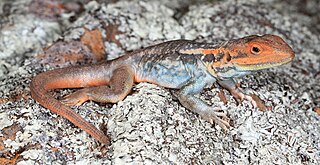
Ctenophorus decresii, also known commonly as the tawny dragon or the tawny crevice-dragon, is a species of lizard in the family Agamidae. The species is endemic to Australia. The average snout-to-vent length (SVL) of the species is 80.76 mm (3.180 in) with larger individuals being around 89 mm (3.5 in) and smaller individuals around 72 mm (2.8 in). The optimal time for mating in this species is two to three weeks after the females emerge from hibernation. Eggs are typically laid from September to October with most of them being laid earlier in the period. C. decresii is known for its variations in throat colors which change based on environmental conditions. Its primary food sources consist of both vegetation and invertebrates, and it prefers to live in rocky habitats.
The gibber earless dragon also known as the smooth-snouted earless dragon, is a species of agamid lizard endemic to Australia. It is one of a documented species of the genus Tympanocryptis, a group of small terrestrial lizards that feed off invertebrates and are characterised by the absence of an external ear structure.
Ctenophorus mckenziei, more commonly known as the dwarf-bicycle dragon, is a species of endemic Australian lizard within the family Agamidae and genus Ctenophorus. Originally identified as the agamid Amphibolurus mckenziei, the lizard had been identified within the regions of Western Australia and South Australia in which it occupied the shrubbery and woodland areas as its habitat. It was subsequently transferred to the genus Ctenophorus along with other Agamid species in which it shared similar morphology and characteristics. The name mckenziei is in reference to Norman Leslie Mckenzie, who was a zoologist and discovered the existence of the lizard. Listed on the IUCN red list page, threats to its population numbers are evaluated as least concern; however, their numbers are threatened by habitat loss, climate change, and feral predators.
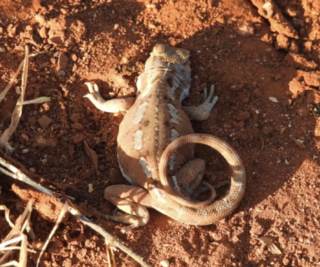
Ctenophorus parviceps, commonly known as the Gnaraloo heath dragon or northwestern heath dragon is a species of agamid lizard occurring in pale coastal sands and shell grit with open heaths and beach spinifex, between the North West Cape and Carnarvon, Western Australia and on Bernier Island. The Gnaraloo heath dragon is a lizard that can be found along the coast of Western Australia between Exmouth Gulf and Shark Bay, and is also known as the northwestern heath dragon. It is native to Australia and usually inhabits sandy coastal dunes. The species' longevity is 3–50 years and its population density is extremely low. The Gnaraloo heath dragon is a member of the Agamidae family, which contains 15 genera. The lizard is under the Ctenophorus genus which has up to 33 species. This genus shows the most morphological and ecological diversity out of the three large agamid genera. 83% of the lizards in this genus lack a crest, while 17% possess crests. They are smaller than most agamids but do have relatively large heads. The Gnaraloo heath dragon can be differentiated from related species by a series of spines on the tail's base, a pale-grey brown broad vertebral band along its back, and hour-glass bars extending upwards to meet the pale vertebral band. It is usually 45mm in terms of length, measuring from snout to vent.

Tropicagama is a genus of large-bodied lizards in the family Agamidae. The genus is monotypic, with only one species listed: Tropicagama temporalis, commonly known as the swamplands lashtail or northern water dragon. This semi-arboreal species inhabits the tropical savannah woodlands of northern Australia, as well as parts of New Guinea and southeastern Indonesia.

Ctenophorus spinodomus commonly known as Eastern Mallee Dragon, is a species of agamid lizard endemic to the arid and semi-arid regions of southeastern Australia. Belonging to the genus Ctenophorus, which comprises a diverse group of 35 species this small lizard is characterised by striking colours and unique behaviours. Commonly known as dragon lizards, spinodomus is derived from the Greek words "spinos" (thorn) and "domos" (house), referring to its preference for burrowing habitats among spiny vegetation. They are curious creatures and can be found darting between the safety of Triodia grass clumps or basking on the red sand.

The Mallee heath dragon, is a species of semi-Arboreal Agamidae endemic to Australia. it has also been referenced as Norris’s dragon, Mallee heath lashtail and Mallee heath lashtail dragon.

Diporiphora nobbi, also known commonly as the nobbi lashtail or the nobbi, is a species of lizard in the family Agamidae. The species is endemic to Australia.
